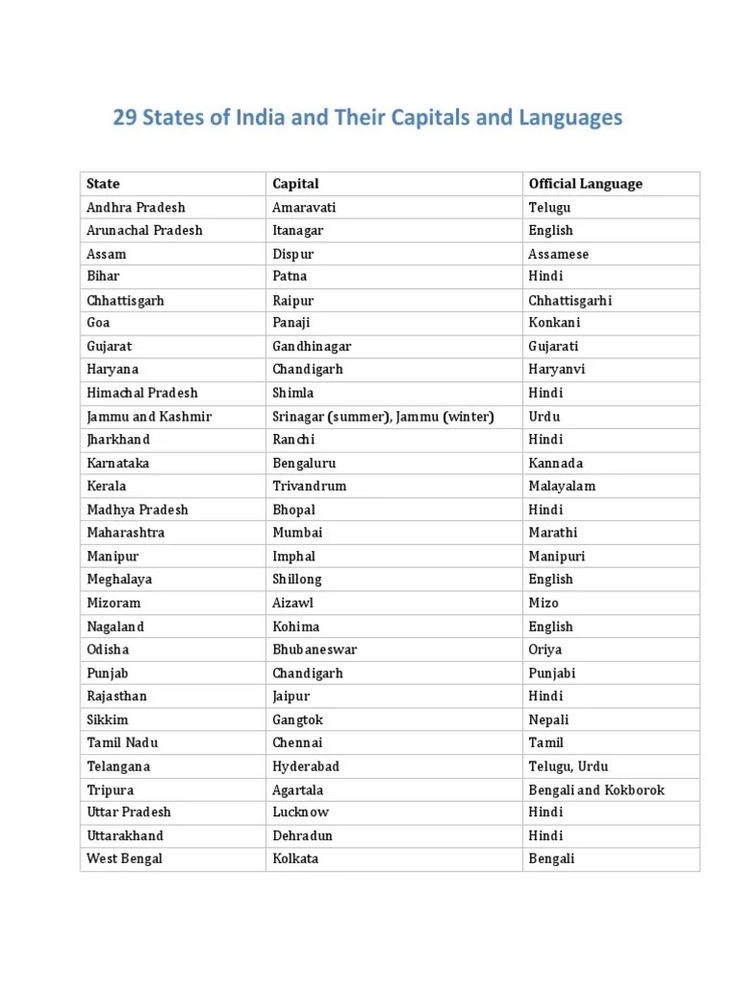28 Indian States and Capitals: Discover Their History, Significance, and Daily Life Impact!
Introduction
India, a land of diverse cultures, languages, and traditions, is divided into 28 states and 8 Union Territories. Each state has its own unique history, identity, and most importantly, a capital that plays a central role in its governance, economy, and cultural development. From bustling metropolitan cities to serene government hubs, the state capitals of India are not just administrative centers, but also vibrant hubs of cultural exchange and social life. This article will explore all the Indian states and capitals, diving deep into their history, facts, significance, and their impact on daily life.
List of all the states in India along with their respective capitals:
1. Andhra Pradesh – Amaravati
2. Arunachal Pradesh – Itanagar
3. Assam – Dispur
4. Bihar – Patna
5. Chhattisgarh – Raipur
6. Goa – Panaji
7. Gujarat – Gandhinagar
8. Haryana – Chandigarh
9. Himachal Pradesh – Shimla
10. Jharkhand – Ranchi
11. Karnataka – Bengaluru
12. Kerala – Thiruvananthapuram
13. Madhya Pradesh – Bhopal
14. Maharashtra – Mumbai
15. Manipur – Imphal
16. Meghalaya – Shillong
17. Mizoram – Aizawl
18. Nagaland – Kohima
19. Odisha – Bhubaneswar
20. Punjab – Chandigarh
21. Rajasthan – Jaipur
22. Sikkim – Gangtok
23. Tamil Nadu – Chennai
24. Telangana – Hyderabad
25. Tripura – Agartala
26. Uttar Pradesh – Lucknow
27. Uttarakhand – Dehradun
28. West Bengal – Kolkata
Union Territories and Their Capitals:
- Andaman and Nicobar Islands – Port Blair
- Chandigarh – Chandigarh
- Dadra and Nagar Haveli and Daman and Diu – Daman
- Lakshadweep – Kavaratti
- Delhi – New Delhi (Capital of India)
- Puducherry – Puducherry
Now, We will explore all the Indian states and capitals, diving deep into their history, facts, significance, and their impact on daily life.
1. Andhra Pradesh – Amaravati
History: Amaravati is the newly proposed capital city of Andhra Pradesh, although currently, the de facto capital is Visakhapatnam. The state was bifurcated in 2014, and Amaravati was planned to symbolize the state’s development.
Daily Life Impact: Life in Amaravati is growing steadily with many developmental projects. It aims to become an ultra-modern city in the future, with a blend of traditional culture.
Significance: The city is poised to be the political, economic, and cultural center of the state, marking a new era in Andhra Pradesh’s history.
2. Arunachal Pradesh – Itanagar
History: Itanagar, the capital of Arunachal Pradesh, was formed in the 1980s. The city sits in the northeastern part of India, bordered by Bhutan, China, and Myanmar.
Daily Life Impact: Itanagar offers a peaceful lifestyle, with its residents benefiting from its close-knit community and proximity to beautiful natural landscapes.
Significance: Itanagar serves as the gateway to the northeastern region and plays a crucial role in maintaining the cultural heritage of the indigenous tribes.
3. Assam – Dispur
History: Dispur became the capital of Assam in 1972, located within the city of Guwahati. Assam’s capital has witnessed major cultural, social, and economic transitions.
Daily Life Impact: Dispur is a hub of commerce and governance, but the people enjoy a slower pace of life compared to other metropolitan cities. It’s known for its serene environment and tea gardens.
Significance: The city symbolizes Assam’s rich cultural diversity and serves as a focal point for trade and politics in the region.
4. Bihar – Patna
History: Patna, formerly known as Pataliputra, has a history dating back to the Mauryan Empire. It was the capital of several ancient Indian kingdoms and empires.
Daily Life Impact: Patna has a bustling market culture, with a mixture of old and new. The daily life is influenced by the historical significance of the city and its position as a business and educational hub.
Significance: Patna remains a symbol of Bihar’s rich cultural and historical heritage. It plays an essential role in politics, education, and commerce.
5. Chhattisgarh – Raipur
History: Raipur became the capital of Chhattisgarh after the state’s formation in 2000. It was once an important city for trade and commerce during the British era.
Daily Life Impact: Raipur is rapidly developing, with significant improvements in infrastructure, commerce, and educational facilities, shaping the lifestyle of its residents.
Significance: Raipur is vital for Chhattisgarh’s industrial and agricultural growth, making it a hub of economic activity in the region.
6. Goa – Panaji
History: Panaji, formerly known as Pangim, has been the capital of Goa since 1961, after it became part of India. The city blends Portuguese influences with Indian traditions.
Daily Life Impact: Known for its laid-back coastal lifestyle, Panaji attracts both locals and tourists, with its picturesque beaches, cultural festivities, and vibrant night-life.
Significance: Panaji is not only the political capital but also the cultural and tourist hub of Goa, showcasing Goa’s unique Portuguese-influenced culture.
7. Gujarat – Gandhinagar
History: Gandhinagar, established in 1960, was designed as a modern city and is named after Mahatma Gandhi. It is located near Ahmedabad, Gujarat’s largest city.
Daily Life Impact: Gandhinagar is a planned city with a peaceful environment, and life revolves around its government institutions and educational centers.
Significance: The city holds great political importance, and its planned design symbolizes Gujarat’s progressive vision.
8. Haryana – Chandigarh
History: Chandigarh serves as the capital of both Haryana and Punjab, created as a union territory in 1966. It was designed by the famous architect Pierre Jeanneret and Le Corbusier.
Daily Life Impact: Known for its modern architecture, Chandigarh is a well-planned city with an emphasis on green spaces. The daily life is influenced by its well-maintained infrastructure and clean environment.
Significance: Chandigarh is the epitome of modern urban planning and is a key cultural and educational hub.
9. Himachal Pradesh – Shimla
History: Shimla served as the summer capital of British India and continues to be the capital of Himachal Pradesh. The city’s colonial charm is still visible in its architecture.
Daily Life Impact: Shimla is known for its peaceful atmosphere, with a slow-paced lifestyle that emphasizes outdoor activities like trekking and sightseeing.
Significance: Shimla’s cool climate, historical significance, and natural beauty make it an important tourist destination.
10. Jammu & Kashmir – Srinagar (Summer) and Jammu (Winter)
History: Srinagar has been the summer capital of Jammu & Kashmir, while Jammu serves as the winter capital. The unique dual capital system was established in the 19th century.
Daily Life Impact: The lifestyle varies between the two cities—Srinagar is known for its lakes and gardens, while Jammu has a more traditional feel, with a focus on religious tourism.
Significance: Both cities serve as essential cultural, political, and economic hubs for the region, with Srinagar being especially important for tourism.
11. Karnataka – Bengaluru
History: Bengaluru, once known as Bangalore, has evolved from a sleepy military town to the tech capital of India. It became the capital of Karnataka in 1830.
Daily Life Impact: Life in Bengaluru is fast-paced, with a tech-driven economy. The city’s residents are known for their progressive mindset and love for cafes and parks.
Significance: Bengaluru is the hub of India’s IT industry, influencing global technology trends and offering immense opportunities for professionals.
12. Kerala – Thiruvananthapuram
History: Thiruvananthapuram, formerly known as Trivandrum, has been the capital of Kerala since the formation of the state in 1956.
Daily Life Impact: The city is known for its educational institutions and relaxed coastal lifestyle. The residents enjoy a high quality of life with access to scenic beauty and culture.
Significance: Thiruvananthapuram is the political and cultural capital of Kerala, known for its rich history and as a hub for education and research.
Conclusion
India’s state capitals are much more than political centers. They are cultural, economic, and historical hubs that shape the daily lives of their citizens. From the bustling streets of Bengaluru to the serene landscapes of Shimla, each capital holds its unique significance and plays a pivotal role in the nation’s development. Understanding the diversity of India’s state capitals helps us appreciate the richness of Indian society and culture.










